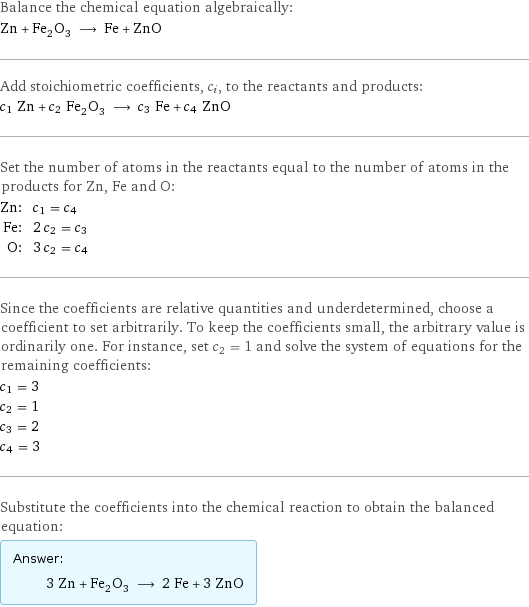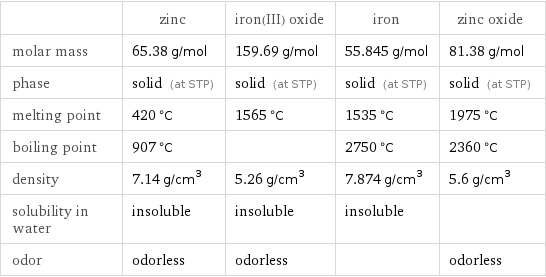Input interpretation

Zn zinc + Fe_2O_3 iron(III) oxide ⟶ Fe iron + ZnO zinc oxide
Balanced equation

Balance the chemical equation algebraically: Zn + Fe_2O_3 ⟶ Fe + ZnO Add stoichiometric coefficients, c_i, to the reactants and products: c_1 Zn + c_2 Fe_2O_3 ⟶ c_3 Fe + c_4 ZnO Set the number of atoms in the reactants equal to the number of atoms in the products for Zn, Fe and O: Zn: | c_1 = c_4 Fe: | 2 c_2 = c_3 O: | 3 c_2 = c_4 Since the coefficients are relative quantities and underdetermined, choose a coefficient to set arbitrarily. To keep the coefficients small, the arbitrary value is ordinarily one. For instance, set c_2 = 1 and solve the system of equations for the remaining coefficients: c_1 = 3 c_2 = 1 c_3 = 2 c_4 = 3 Substitute the coefficients into the chemical reaction to obtain the balanced equation: Answer: | | 3 Zn + Fe_2O_3 ⟶ 2 Fe + 3 ZnO
Structures

+ ⟶ +
Names

zinc + iron(III) oxide ⟶ iron + zinc oxide
Reaction thermodynamics
Enthalpy

| zinc | iron(III) oxide | iron | zinc oxide molecular enthalpy | 0 kJ/mol | -826 kJ/mol | 0 kJ/mol | -350.5 kJ/mol total enthalpy | 0 kJ/mol | -826 kJ/mol | 0 kJ/mol | -1052 kJ/mol | H_initial = -826 kJ/mol | | H_final = -1052 kJ/mol | ΔH_rxn^0 | -1052 kJ/mol - -826 kJ/mol = -225.5 kJ/mol (exothermic) | | |
Entropy

| zinc | iron(III) oxide | iron | zinc oxide molecular entropy | 42 J/(mol K) | 90 J/(mol K) | 27 J/(mol K) | 44 J/(mol K) total entropy | 126 J/(mol K) | 90 J/(mol K) | 54 J/(mol K) | 132 J/(mol K) | S_initial = 216 J/(mol K) | | S_final = 186 J/(mol K) | ΔS_rxn^0 | 186 J/(mol K) - 216 J/(mol K) = -30 J/(mol K) (exoentropic) | | |
Equilibrium constant
![Construct the equilibrium constant, K, expression for: Zn + Fe_2O_3 ⟶ Fe + ZnO Plan: • Balance the chemical equation. • Determine the stoichiometric numbers. • Assemble the activity expression for each chemical species. • Use the activity expressions to build the equilibrium constant expression. Write the balanced chemical equation: 3 Zn + Fe_2O_3 ⟶ 2 Fe + 3 ZnO Assign stoichiometric numbers, ν_i, using the stoichiometric coefficients, c_i, from the balanced chemical equation in the following manner: ν_i = -c_i for reactants and ν_i = c_i for products: chemical species | c_i | ν_i Zn | 3 | -3 Fe_2O_3 | 1 | -1 Fe | 2 | 2 ZnO | 3 | 3 Assemble the activity expressions accounting for the state of matter and ν_i: chemical species | c_i | ν_i | activity expression Zn | 3 | -3 | ([Zn])^(-3) Fe_2O_3 | 1 | -1 | ([Fe2O3])^(-1) Fe | 2 | 2 | ([Fe])^2 ZnO | 3 | 3 | ([ZnO])^3 The equilibrium constant symbol in the concentration basis is: K_c Mulitply the activity expressions to arrive at the K_c expression: Answer: | | K_c = ([Zn])^(-3) ([Fe2O3])^(-1) ([Fe])^2 ([ZnO])^3 = (([Fe])^2 ([ZnO])^3)/(([Zn])^3 [Fe2O3])](../image_source/022baee96c09d7a89a0c4c3d2094253b.png)
Construct the equilibrium constant, K, expression for: Zn + Fe_2O_3 ⟶ Fe + ZnO Plan: • Balance the chemical equation. • Determine the stoichiometric numbers. • Assemble the activity expression for each chemical species. • Use the activity expressions to build the equilibrium constant expression. Write the balanced chemical equation: 3 Zn + Fe_2O_3 ⟶ 2 Fe + 3 ZnO Assign stoichiometric numbers, ν_i, using the stoichiometric coefficients, c_i, from the balanced chemical equation in the following manner: ν_i = -c_i for reactants and ν_i = c_i for products: chemical species | c_i | ν_i Zn | 3 | -3 Fe_2O_3 | 1 | -1 Fe | 2 | 2 ZnO | 3 | 3 Assemble the activity expressions accounting for the state of matter and ν_i: chemical species | c_i | ν_i | activity expression Zn | 3 | -3 | ([Zn])^(-3) Fe_2O_3 | 1 | -1 | ([Fe2O3])^(-1) Fe | 2 | 2 | ([Fe])^2 ZnO | 3 | 3 | ([ZnO])^3 The equilibrium constant symbol in the concentration basis is: K_c Mulitply the activity expressions to arrive at the K_c expression: Answer: | | K_c = ([Zn])^(-3) ([Fe2O3])^(-1) ([Fe])^2 ([ZnO])^3 = (([Fe])^2 ([ZnO])^3)/(([Zn])^3 [Fe2O3])
Rate of reaction
![Construct the rate of reaction expression for: Zn + Fe_2O_3 ⟶ Fe + ZnO Plan: • Balance the chemical equation. • Determine the stoichiometric numbers. • Assemble the rate term for each chemical species. • Write the rate of reaction expression. Write the balanced chemical equation: 3 Zn + Fe_2O_3 ⟶ 2 Fe + 3 ZnO Assign stoichiometric numbers, ν_i, using the stoichiometric coefficients, c_i, from the balanced chemical equation in the following manner: ν_i = -c_i for reactants and ν_i = c_i for products: chemical species | c_i | ν_i Zn | 3 | -3 Fe_2O_3 | 1 | -1 Fe | 2 | 2 ZnO | 3 | 3 The rate term for each chemical species, B_i, is 1/ν_i(Δ[B_i])/(Δt) where [B_i] is the amount concentration and t is time: chemical species | c_i | ν_i | rate term Zn | 3 | -3 | -1/3 (Δ[Zn])/(Δt) Fe_2O_3 | 1 | -1 | -(Δ[Fe2O3])/(Δt) Fe | 2 | 2 | 1/2 (Δ[Fe])/(Δt) ZnO | 3 | 3 | 1/3 (Δ[ZnO])/(Δt) (for infinitesimal rate of change, replace Δ with d) Set the rate terms equal to each other to arrive at the rate expression: Answer: | | rate = -1/3 (Δ[Zn])/(Δt) = -(Δ[Fe2O3])/(Δt) = 1/2 (Δ[Fe])/(Δt) = 1/3 (Δ[ZnO])/(Δt) (assuming constant volume and no accumulation of intermediates or side products)](../image_source/e0e56c0f1c73e16d7a2551d78328ff3b.png)
Construct the rate of reaction expression for: Zn + Fe_2O_3 ⟶ Fe + ZnO Plan: • Balance the chemical equation. • Determine the stoichiometric numbers. • Assemble the rate term for each chemical species. • Write the rate of reaction expression. Write the balanced chemical equation: 3 Zn + Fe_2O_3 ⟶ 2 Fe + 3 ZnO Assign stoichiometric numbers, ν_i, using the stoichiometric coefficients, c_i, from the balanced chemical equation in the following manner: ν_i = -c_i for reactants and ν_i = c_i for products: chemical species | c_i | ν_i Zn | 3 | -3 Fe_2O_3 | 1 | -1 Fe | 2 | 2 ZnO | 3 | 3 The rate term for each chemical species, B_i, is 1/ν_i(Δ[B_i])/(Δt) where [B_i] is the amount concentration and t is time: chemical species | c_i | ν_i | rate term Zn | 3 | -3 | -1/3 (Δ[Zn])/(Δt) Fe_2O_3 | 1 | -1 | -(Δ[Fe2O3])/(Δt) Fe | 2 | 2 | 1/2 (Δ[Fe])/(Δt) ZnO | 3 | 3 | 1/3 (Δ[ZnO])/(Δt) (for infinitesimal rate of change, replace Δ with d) Set the rate terms equal to each other to arrive at the rate expression: Answer: | | rate = -1/3 (Δ[Zn])/(Δt) = -(Δ[Fe2O3])/(Δt) = 1/2 (Δ[Fe])/(Δt) = 1/3 (Δ[ZnO])/(Δt) (assuming constant volume and no accumulation of intermediates or side products)
Chemical names and formulas

| zinc | iron(III) oxide | iron | zinc oxide formula | Zn | Fe_2O_3 | Fe | ZnO Hill formula | Zn | Fe_2O_3 | Fe | OZn name | zinc | iron(III) oxide | iron | zinc oxide IUPAC name | zinc | | iron | oxozinc
Substance properties

| zinc | iron(III) oxide | iron | zinc oxide molar mass | 65.38 g/mol | 159.69 g/mol | 55.845 g/mol | 81.38 g/mol phase | solid (at STP) | solid (at STP) | solid (at STP) | solid (at STP) melting point | 420 °C | 1565 °C | 1535 °C | 1975 °C boiling point | 907 °C | | 2750 °C | 2360 °C density | 7.14 g/cm^3 | 5.26 g/cm^3 | 7.874 g/cm^3 | 5.6 g/cm^3 solubility in water | insoluble | insoluble | insoluble | odor | odorless | odorless | | odorless
Units
